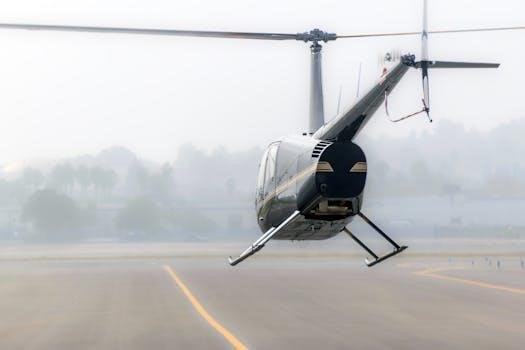Types of Aircraft
The aviation spectrum includes many aircraft types, such as airships, gliders, general aviation airplanes, airliners, and helicopters. Understanding these categories, classes, and types is crucial. This guide delves into various aircraft, each designed for specific purposes, with diverse capabilities.
Single-Engine Aircraft
Single-engine aircraft represent a significant portion of general aviation, offering versatility for training, personal transportation, and recreational flying. These aircraft are characterized by having one engine, typically a piston engine driving a propeller. Single-engine planes are often more economical to operate and maintain compared to their multi-engine counterparts, making them a popular choice for new pilots and flight schools. They come in various configurations, including high-wing and low-wing designs, each offering unique handling characteristics. These aircraft are commonly used for short to medium-range flights and are found in a wide range of sizes and performance capabilities. From small, two-seat trainers to larger, more capable personal aircraft, single-engine planes play a vital role in the aviation ecosystem, enabling many to experience the freedom of flight. They also serve crucial roles in agricultural applications and aerial photography.
Multi-Engine Aircraft
Multi-engine aircraft are characterized by having more than one engine, offering increased power, redundancy, and often, enhanced safety features. These aircraft are essential for commercial aviation, air transport, and long-distance travel. Multi-engine planes provide added safety through engine redundancy, allowing for continued flight even if one engine fails. They are available in a range of designs, from light twins to large transport category aircraft. The increased power enables them to carry heavier payloads, travel greater distances, and operate at higher altitudes. Many business jets and cargo aircraft fall into this category. Operating multi-engine aircraft requires additional training and certifications for pilots, due to their complexity and handling characteristics. The presence of multiple engines allows for increased operational flexibility and passenger capacity. They are a cornerstone of modern aviation, enabling global connectivity and transportation.
Propeller-Driven Aircraft
Propeller-driven aircraft are a cornerstone of aviation, utilizing propellers to generate thrust. These aircraft range from small, single-engine trainers to larger, multi-engine transports. The propeller’s rotation creates a pressure difference, propelling the aircraft forward. They are known for their efficiency at lower speeds and altitudes, making them suitable for short-haul flights, general aviation, and flight training. Propeller-driven aircraft can be powered by piston engines or turboprop engines. Piston engines are common in smaller aircraft, while turboprops offer more power for larger planes. The simplicity and reliability of propeller-driven systems make them a popular choice. They are used in various applications, including agricultural aviation, recreational flying, and regional transportation; Propeller aircraft offer a diverse range of capabilities, with each type designed to meet specific needs within the aviation world.
Turboprop Aircraft
Turboprop aircraft are a distinct category, combining features of both propeller-driven and jet aircraft. They utilize a turbine engine to drive a propeller, offering a balance of speed and efficiency. Unlike jet engines which produce thrust directly, turboprops use their power to turn a propeller which then propels the aircraft forward. This design makes them efficient at medium altitudes and speeds, ideal for regional air travel and cargo transport. Turboprops are known for their reliability and fuel efficiency, especially when compared to jet aircraft at shorter distances. They often operate in environments where shorter runways are common. The versatility of turboprops makes them suitable for a wide range of missions, from passenger transport to specialized applications like aerial surveying and cargo delivery. Their design allows them to perform well in various conditions, making them a practical choice for many operators.
Jet Aircraft
Jet aircraft represent a pinnacle of aviation technology, utilizing jet engines to generate thrust and propel the aircraft forward. These engines operate by taking in air, compressing it, mixing it with fuel, and igniting the mixture to produce high-speed exhaust, creating powerful thrust. This allows jet aircraft to reach high altitudes and travel at speeds far exceeding those of propeller-driven aircraft. Jet aircraft are used for various purposes, including commercial passenger travel, cargo transport, and military operations. Their ability to fly at high altitudes allows them to avoid weather disturbances and ensures smoother flights. Jet aircraft are known for their speed, efficiency over long distances, and ability to operate in diverse conditions, making them the standard for long-haul routes. They are available in various sizes, from smaller private jets to massive wide-body airliners, each suited to different needs and operations.

Types of Approaches in Aviation
Approaches guide pilots through safe descents, often in challenging conditions. This section explores the various types of approaches used in aviation. These different approaches ensure safe and controlled landings in diverse situations.
Precision Approach (PA)
Precision approaches are a critical aspect of aviation, offering pilots the highest level of accuracy and guidance during the final stages of landing. These approaches utilize both lateral and vertical guidance, providing pilots with precise information about their position relative to the runway. The most common example of a precision approach is the Instrument Landing System (ILS), which employs radio signals to guide the aircraft. Specifically, the ILS uses a localizer for lateral guidance, a glide slope for vertical guidance, and marker beacons to indicate distance from the runway threshold. Pilots must carefully tune the ILS frequency into their aircraft’s radio navigation system. This system ensures pilots have the necessary information for a safe and precise landing, even in low visibility conditions. Precision approaches are instrumental in maintaining safety standards and efficiency in air travel, particularly at busy airports.

Non-Precision Approach (NPA)
Non-precision approaches, unlike their precision counterparts, provide lateral guidance to pilots during the final approach phase but do not offer vertical guidance. These approaches rely on navigational aids such as VOR (VHF Omnidirectional Range), NDB (Non-Directional Beacon), or RNAV (Area Navigation) systems. Pilots use these aids along with charts to determine their position and descent path. A common example of NPA is the Localizer Type Directional Approach (LDA), which uses a ground-based transmitter from an ILS but without the complete ILS signal. NPAs require pilots to calculate their descent rate and altitude using the provided information. These approaches are essential in situations where precision approach aids are unavailable or not feasible. While they may not offer the same level of precision as PAs, they provide a safe means for landing when conditions permit.
Approaches with Vertical Guidance (APV)
Approaches with Vertical Guidance (APV) bridge the gap between precision and non-precision approaches, offering a crucial element of safety and accuracy. APV approaches provide pilots with both lateral and vertical guidance, enhancing situational awareness during descent. These approaches often utilize technologies like GPS and WAAS (Wide Area Augmentation System) to offer more accurate and reliable guidance. An example of APV is the RNAV approach with LPV (Localizer Performance with Vertical guidance). APV approaches are essential at airports that may not have full precision landing systems, they offer improved safety and reliability compared to traditional non-precision approaches. APV approaches are becoming increasingly common due to the availability of satellite based navigation systems. The use of APV aids in reduced minima and increased operational efficiency.

Aeronautical Charts
Aeronautical charts are vital tools for aviation navigation, providing crucial information such as airspace boundaries, airways, waypoints, and airport data. These charts come in two primary types⁚ Visual Flight Rules (VFR) and Instrument Flight Rules (IFR).
Visual Flight Rules (VFR) Charts
VFR charts are designed for pilots flying under Visual Flight Rules, where navigation is primarily based on visual references to the ground. These charts are essential for maintaining situational awareness and avoiding obstacles. They depict terrain features, landmarks, and significant structures, alongside vital information like airspace boundaries, radio frequencies, and airport details. VFR charts use color-coding and symbols to represent various elements clearly. They are crucial for flight planning, helping pilots navigate safely by visually identifying their position, planning routes, and avoiding controlled airspace. These charts are frequently updated to reflect changes in airspace and navigational aids. They are an essential part of any pilot’s toolkit for VFR flight, ensuring a safe and informed flight experience. VFR charts are also useful for pilots learning to navigate visually and understand the airspace and terrain.

